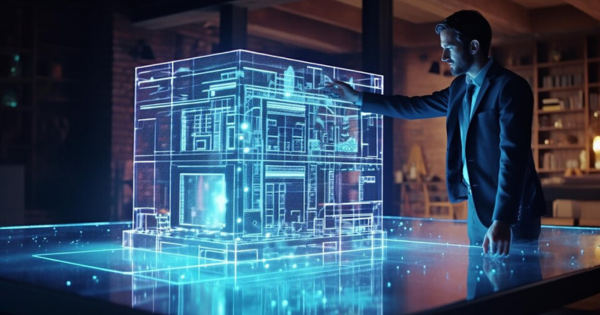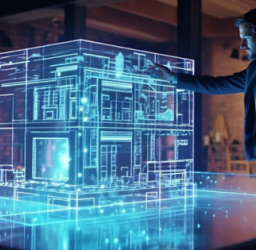Top BIM Trends Shaping the Construction Industry in 2024

BIM Modeling services have transformed the landscape of the Architecture, Engineering, and Construction(AEC) industry, revolutionizing the way projects are designed and executed.
BIM technology has instilled the construction process with high accuracy, efficiency, and simplified workflow. The fundamental objective of using these services is to improve project performance and ensure high construction quality.
Several innovative trends in BIM modeling services are yet to emerge as a transformative force for the industry. As per reports, the BIM market is supposed to grow with a CAGR of 13.7%, during the forecast period 2023–28.
Let’s delve deeper to find an answer to the future of the construction industry and the expected technology boom for 2024.
Top 10 innovative trends of BIM Modeling Services
In the ever-evolving domain of technology and the digital world, certain innovative trends will transform the scenario of building design and witness a major surge in the upcoming year. Here are the top 10 trends that can provide AEC professionals with an immersive design experience:
Integration of Augmented Reality(AR) and Virtual Reality(VR)
AR and VR integration in BIM modeling services fosters the revolutionizing design and construction processes. The VR technology provides an immersive experience of a three-dimensional space, imparting a better understanding of spatial relationships and design aesthetics.
AR overlays digital information onto the physical world, enhancing the on-site construction work. These technologies combined improve visualization, provide project previews with virtual walkthroughs, reduce errors, and improve communication between project stakeholders.
EXPLORE ALL BIM TRAINING OPPORTUNITIES BY UDC TRAINING CYPRUS
Generative Design and AI Integration
Artificial Intelligence and generative design are among the significant trends catering to BIM modeling services. Generative design algorithms leverage AI to explore countless design options based on various parameters. It enables architects and engineers in cost and performance optimization, leading to quality-driven project outcomes.
This process gradually enhances creativity, speeds up design processes, and results in efficient structures. AI and Machine Learning are also being used for project scheduling, cost estimation, and risk analysis before construction work.
Digital Twin technology
Digital twin technology is a digital representation model devised for replicating a physical asset or system for construction purposes. It enables the stakeholders to monitor, analyze, and enhance building performance throughout its lifecycle.
From design, construction, operation, and maintenance, digital twin technology provides a comprehensive view, resulting in better resource management and decision-making. The construction projects with high-site traffic, such as shopping malls, auditoriums, or stadiums, can benefit from the integration of this virtual tool.
EXPLORE ALL BIM TRAINING OPPORTUNITIES BY UDC TRAINING CYPRUS
Prefabrication and Modular Construction
Prefabrication is the off-site design and fabrication of building components in a factory or workshop. Modular construction and prefabrication have surged in recent years in the construction industry, addressing safety, faster project delivery, improved quality control, and productivity issues.
The building elements are customized according to the project’s requirements, making the prefabrication process an efficient and streamlined solution to building construction. Modular construction involves the standardized development of modules, further incorporated into a project according to the requirements. Integrating modular design elements with on-site construction facilitates sustainable and flexible building construction.
Internet of Things (IoT) for Smart Buildings
The Internet of Things(IoT) is a tool that uses a sensor embedded in an object to monitor its operating state. The development of smart buildings is governed by the use of IoT, and BIM Modeling services are at the forefront of this transformation.
BIM is used to include IoT sensors and devices into a project, enabling real-time monitoring and control of various systems like HVAC, Lighting, and security. The real-time information collected with updated data flow and cloud technologies enhances the operational and construction efficiency of a project.
The use of IoT with the concept of smart buildings allows for efficient building management, predictive maintenance, energy monitoring, and enhanced design functionality.
3D Printing
3D printing is a technique of generating 3D digital models or prototypes of the project elements. When compared to traditional construction methods, 3D printing is cost-effective and seamless. It can also be used to develop prefabricated or modular structures with fewer materials and reduced wastage.
These printers are capable of creating a three-dimensional object from a digital file prepared with Revit BIM modeling services.
Robotics in Construction
The adoption of robotics in the execution of project construction has transformed the way buildings and infrastructure are executed on-site. Robotics and automation are used rapidly for repetitive and labor-intensive tasks. Robots help with bricklaying, concrete pouring, material handling, and autonomous construction equipment.
Automation can free up human labor, focusing on more strategic and skilled tasks. It reduces the number of accidents on construction sites and improves efficient workflow. This evolution of technology enhances precision, decreases labor costs, improves productivity, and accelerates the construction timeline.
EXPLORE ALL BIM TRAINING OPPORTUNITIES BY UDC TRAINING CYPRUS
Cloud-Based Collaboration
Cloud-based BIM modeling services are a revolutionary advancement for the AEC industry. It facilitates real-time collaboration among project stakeholders, streamlines workflows, and ensures that all team members are aligned with each other. It allows anyone in any location to access project data at any time.
Revit BIM Modeling services enhance communication and collaboration amongst stakeholders by providing a common information-sharing platform.
Integration of Sustainability
Sustainability is gaining momentum and becoming the epicenter of the AEC industry. Architects and designers develop projects involving energy consumption, interior environmental quality, annual CO2 emissions, cost projections for various electrical equipment, and performance simulations.
The BIM service allows the examination and comparison of various green energy sources such as wind turbines, photovoltaics, solar panels, and other high-efficiency appliances.
The architects are empowered to create sustainable structures from the initial design phase and post-load design energy modeling calculates the amount of heating and cooling energy required by the structure.
Blockchain for Data Security
A critical concern in the AEC industry is data security, especially when dealing with sensitive data in BIM models. Integrating blockchain technology provides a secure and transparent way to share and manage project information.
It ensures data integrity, traceability, and accountability, improving the security of BIM modeling services. Blockchain security reduces the risk of unauthorized access or data manipulation.
Conclusion
These innovative trends in the BIM modeling services are expected to redefine the way buildings are conceived, altering the dynamics of the construction industry in 2024. This ever-evolving technology will result in a seismic shift towards safety, accuracy, sustainability, and efficiency.
The preferable way to gain an edge in the market is to integrate BIM with advanced technology, serving as a one-stop solution for designers. It streamlines the operational tasks and provides a competitive advantage to your project.
Embracing these trends will not only revamp the building landscape but also pave the way for a more connected and intelligent built environment. The convergence of technology and design molds the future of the AEC industry with BIM functioning at the forefront of this transformation.
Share:
Διαβάστε Επίσης
Η μετάβαση όμως στην ηλεκτροκίνηση είναι πολύ περισσότερη από απλή αντικατάσταση των κινητήρων εσωτερικής καύσης με ηλεκτρικούς.
Το BIM δεν είναι απλώς ένα εργαλείο τρισδιάστατου σχεδιασμού.
 Ελληνικά
Ελληνικά  English
English


